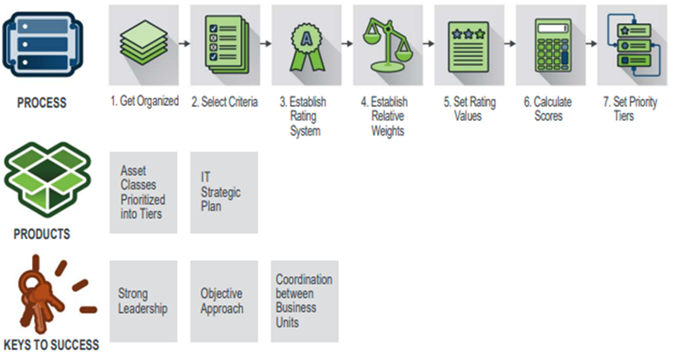- Chapters
-
Chapter 2
Sections - Chapter 2 Home Page
- Chapter PDF
Chapter 2
Quick Links
2.5.2
Selecting Assets for Inclusion in Asset Management Programs
This subsection discusses the challenges agencies face in expanding asset management programs due to limited resources and budget constraints. It introduces a handbook that outlines a seven-step process for prioritizing asset classes, providing examples of typical highway ancillary asset classes and illustrating how agencies like Nevada and Ohio establish priority tiers for efficient data collection and management aligned with their management priorities.
Organizations face constraints on resources and budgets. Therefore, those seeking to broaden their asset management programs by incorporating additional information require a method for assessing the benefits and costs of system development, data collection, and data management. The Handbook for Integrating Ancillary Assets into TAM Programs (FHWA 2019) presents structured approaches, outputs, and essential guidelines concerning the steps needed to formulate a prioritized strategy for integrating asset classes. Prioritization is crucial to ensure the effective and efficient use of limited resources. The Handbook outlines a seven-step procedural framework fostering collaboration among business units with asset data requirements or responsibilities in data collection and management. Determining which asset classes to include in an organization's asset management program hinges on a thorough grasp of the organization's IT policies, architecture, and strategies.
Figure 2.11 Prioritization Overview
Typical asset classes considered though this process can be extensive. The assets listed in Table 2.2 are an illustration of potential classes that may be considered by agencies, and was compiled in the Handbook (FHWA 2019), adapted from NHI 2017.
Table 2.2 - Typical Highway Ancillary Asset Classes
| FUNCTIONAL AREA | ASSET CLASS | ||||||
|---|---|---|---|---|---|---|---|
| Structures (not Bridges or otherwise in the National Bridge Inventory) |
| ||||||
| Traffic Control and Management—Active Devices |
| ||||||
| Traffic Control and Management—Passive Control Devices |
| ||||||
| Drainage Systems and Environmental Mitigation Features |
| ||||||
| Other Safety Features |
| ||||||
| Roadside Features |
| ||||||
| Other Facilities and Other Items |
|
*See NCHRP Research Report 903: Geotechnical Asset Management for Transportation Agencies (FHWA 2019) for more details on best practice for managing geotechnical assets.
Many agencies institute priority tiers to group asset classes, enabling the development of distinct plans for gathering, storing, and managing necessary data in accordance with management objectives. Determining which assets to include in a specific implementation project depends on a wide range of interconnected factors, rendering the development of a precise ranked order for all assets challenging. Streamlining this process can be achieved through the adoption of a tiered system which groups assets of comparable priority together. As exemplified in Table 2.3, both Nevada and Ohio compiled ranked lists that can be translated into prioritized tiers. Each agency possesses distinct priorities and can utilize a similar methodical approach to assess their portfolio within the framework of their operational and strategic planning capabilities, as well as their management objectives.
Table 2.3 - Examples of prioritized tiers developed by Nevada and Ohio DOTs
Adapted from 2019 FHWA Handbook on Ancillary Asset Management
| TIER LEVEL | NEVADA DOT | OHIO DOT |
|---|---|---|
| I |
|
|
| II |
|
|
| III |
|
|

